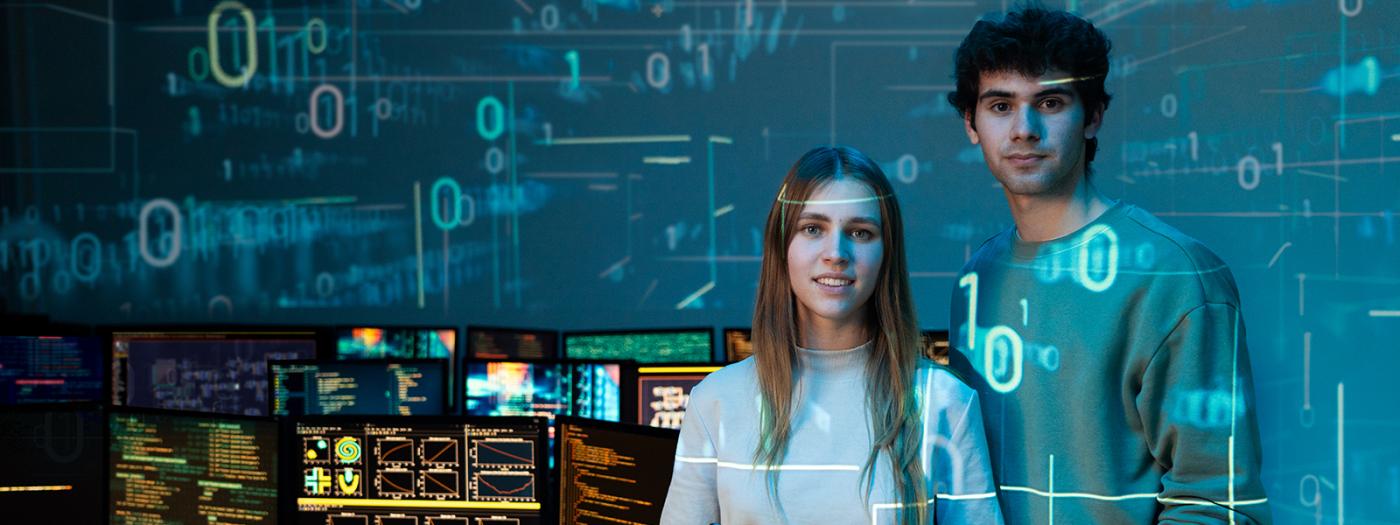In this subject the techniques and the methodologies used for the digital system design are explained. In first place, the secuential systems are studied. From these systems, the students may design synchronous digital systems of specific process. Then, the microprocessors and microcontrollers are presented. We study the PIC18F4321 microcontroller and its programming with assembler. Finally, we study the design in C software for microcontrollers based in a cooperative methodology.
Basic concepts on Boolean algebra and combinational systems.
The students of this subject will learn the following knowledge and develop the skills listed below:
1.- Improve the basic knowledge of combinational and sequential systems.
2.- Acquire the basic knowledge about the study of digital systems with MSI components and with microprocessors.
3.- Study different methodologies of the digital system design.
4.- Design and implement sequential-system processes at the laboratory working in groups in order to reinforce their knowledge and analyze its functioning.
5.- To acquire the basic abilities to identify problems in the implementations done at the laboratory.
1. Digital systems review
Logical families.
Considerations about consume and velocity.
Combinational systems.
Binary arithmetic.
2. Sequential systems
Biestables, registers, synchronous computers and applications.
Memories: RAM, LIFO, FIFO, CAM, etc.
Synchronous sequential systems: 1:N, N:M, etc.
3. Digital systems of specific process
Synchronization unit.
Control unit.
Operative unit.
Interface.
4. Introduction to microcontrollers
Microprocessor and microcontroller.
Basic structure: CPU, memory, peripheries.
Instruction groups.
Addressing mode.
Concept of direct access to memory.
5. PIC18F4321 - Introduction
Microchip microprocessors range.
General characteristics.
Blocks diagram and list of pins.
Oscillator modes.
Energy-management modes.
Reset.
6. PIC18F4321: Memory
Memory maps
Program memory.
RAM data memory: general objective, specific and banks.
EEPROM data memory.
Battery.
7. PIC18F4321: Instruction group
Oriented-to-byte Instructions.
Oriented-to-bit instructions.
Literal instructions.
Control instructions.
8. PIC18F4321: interruptions
Concept of interruption.
Priority level of the interruptions.
Interruption sources.
9. PIC18F4321: Peripheries
Ports.
Timers.
Management devices of external interruptions.
ESUART.
A/D converter.
10. C Programming Language and design methodology
C specific synthesis for PIC microprocessors programming.
Cooperative design.
The methodology used in this course is based on magisterial classes reinforced with the accomplishment of two practices in groups of two students. The practices must be handed in along the course and they are the nucleus of the continuous evaluation. The magisterial classes are also complemented with exercises that are solved during classes by the professor.
In this subject an e-campus is used to communicate and share documents between the professor and the students. With this method, all the materials are available during the course (manuals, proposed exercises, solved exercises, exams, theoretical summaries, etc.).
The subject is organized in two semesters and each one has a totally independent evaluation that includes the theoretical exams´ grade and its continuous evaluation.
In reference to the theoretical exams:
- The first semester has a final exam (E1S) that can be taken in February. If the students don´t pass the exam, they may retake it in June or in July.
- The second semester has a final exam (E2S) that is taken in June and the recovery exam may be taken in July.
In reference to the continuous evaluation:
- The continuous evaluation takes into account the student´s progress, planning and continuous work. This evaluation is only of the practical sessions.
- Each one of the two practices of the subject (one per semester) will have 3 Check Points (PC) during the pre-established dates to evaluate the real state of the practices during course.
In reference to the final grades´ calculus:
- The semester´s final grade is calculated as the highest grade between two options: the exam´s grade or the exam´s grade plus the continuous evaluation´s grade, only in the event that the theoretical grade is higher than 3,5.
- To pass the subject is necessary that the final grades of each semester are equal to or higher than 5, and have handed in the two practices. In this case, the subject´s final grade is calculated as the average of the final grades of the two trimesters.
Others:
- Once all the practices are passed, the grade is kept for the next course (only for one course) only if the failed theoretical semester has a grade higher than or equal to 3 in the extraordinary exam in July.
The continuous evaluation notes are taken into account in both the ordinary and the extraordinary exams.
- The students that are exempt of practices (previous approved practices), must solved the practices theoretically as an exercise and hand them in during the same deadlines than the practices, in the event that the continuous evaluation want to be used.
-For the students enrolled in the extraordinary exam in February, the contents of the exam will be the ones from the previous academic course. In this case, the practices that must be completed are the ones from the past course (they must be handed in before the February extraordinary exam) before the extraordinary exam. The practices must be accomplished individually. Once they are handed in, they will be taken into account as passed from the previous course for all its effects.
- The copy in the theory or in the practices is penalized with 0 (zero) points in the ordinary and the extraordinary exam of the 2011-2012 course. Besides, if the professor detects that someone copied during the extraordinary exam in July or during in the practices handed in September, he may penalize with 0 (zero) points the ordinary exam in June of the 2012-2013 course.
- Theoretical exams.
- Carry out practices.
[1] August Climent i Judit Lacomba, Teoria i exercicis de Sistemes Seqüencials de Procés Específic, La Salle, 2005.
[2] F. Escudero, Disseny de sistemes de control cooperatius. Una visió pragmàtica, La Salle, 2009.
[3] August Climent i Antoni Garrell, Introducció al Disseny Digital, La Salle, 1999.
[4] M.Mano and M.D.Ciletti, Digital Design, 4th edition, Prentice Hall, 2007.
[5] Microchip, PIC18F4321 Family Data Sheet, Microchip Technology, 2007.
[6] R.Miles and K.Hamilton, Learning UML 2.0, O'Reilly Media Inc, 2006.
